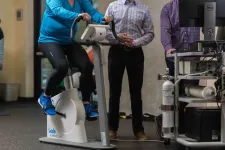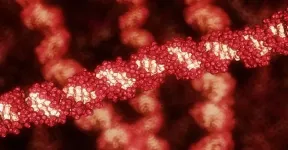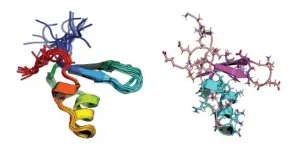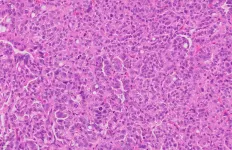Diamond color centers for nonlinear photonics
Researchers at the University of Tsukuba use color center defects in diamonds to demonstrate second-order nonlinear optical effects, which may allow for extremely fast all-optical communication and computation devices.
2021-03-22
(Press-News.org) Tsukuba, Japan - Researchers from the Department of Applied Physics at the University of Tsukuba demonstrated second-order nonlinear optical effects in diamonds by taking advantage of internal color center defects that break inversion symmetry of diamond crystal. This research may lead to faster internet communications, all-optical computers, and even open a route to next generation quantum sensing technologies.
Current fiber optical technology uses light pulses to transfer broad-bandwidth data that let you check your email, watch videos, and everything else on the Internet. The main drawback is that light pulses hardly interact with each other, so the information must be converted into electrical signals to allow your computer to handle it. An "all optical" system with light-based logic processing would be much faster and more efficient. This would require new, easy to fabricate nonlinear optical materials that can mediate the combination or splitting of photons.
Now, a team of researchers at the University of Tsukuba have shown that synthetic diamonds can exhibit a second-order nonlinear response. Previously, scientists thought that the inversion-symmetric nature of diamond crystal lattice could only support weaker, odd-order nonlinear optical effects, which depend on the electric field amplitude raised to the power of three, five, and so on. But the team showed diamonds can support second-order nonlinear optical effects when color centers--so-called nitrogen-vacancy (NV) centers--are introduced. In these cases, two adjacent carbon atoms in the diamond's rigid lattice are replaced with a nitrogen atom and a vacancy. This breaks the inversion symmetry and permits even-order nonlinear processes to occur, which include more useful outcomes that scale as the electric field squared. "Our work allows us to produce powerful second-order nonlinear optical effects, such as second harmonic generation and electro-optic effect, in bulk diamonds," senior author Professor Muneaki Hase says.
The team used chemical vapor-deposited single-crystal diamonds (from Element Six), with extra nitrogen ions implanted to encourage the formation of NV centers. The emission spectrum they observed when the diamonds were excited with 1350-nm light showed clear second- and third-order harmonic peaks (Figure 1). These observations represent the merging of two or three photons, respectively, into a single photon of higher energy. "In addition to new photonic devices, second-order nonlinear optical effect by NV centers in diamonds might be used as the basis of quantum sensing of electromagnetic fields," first author Dr. Aizitiaili Abulikemu says. Because diamonds are already used in industrial applications, they have the advantage of being relatively easily applicable to optical uses.
INFORMATION:
The work has been published in ACS Photonics as "Second-harmonic generation in bulk diamond based on inversion symmetry breaking by color centers." (DOI: 10.1021/acsphotonics.0c01806).
[Attachments] See images for this press release:
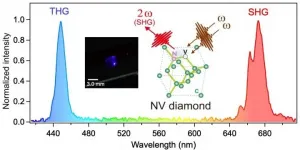
ELSE PRESS RELEASES FROM THIS DATE:
2021-03-22
In a recent study testing the effects of exercise on overall metabolism, researchers at Oregon State University found that even a single session of moderate aerobic exercise makes a difference in the cells of otherwise sedentary people.
Mitochondria are the part of the cell responsible for the biological process of respiration, which turns fuels such as sugars and fats into energy, so the researchers focused only on mitochondria function.
"What we found is that, regardless of what fuel the mitochondria were using, there were mild increases in the ability to burn off the fuels," said Matt Robinson, lead author on the study and an assistant professor ...
2021-03-22
Melbourne researchers have revealed how melanoma cells are flooded with DNA changes as this skin cancer progresses from early, treatable stages through to fatal end-stage disease.
Using genomics, the team tracked DNA changes occurring in melanoma samples donated by patients as their disease progressed, right through to the time the patient died. This revealed dramatic and chaotic genetic changes that accumulated in the melanoma cells as the cancers progressed, providing clues to potential new approaches to treating this disease.
The research, published in Nature Communications, was led by Professor Mark Shackleton, Professor Director of Oncology at Alfred Health and Monash University; Professor ...
2021-03-22
Clinically, multiple lines of evidence show that chronic pain and depressive symptoms are frequently encountered. Patients suffered from both pain and depression are likely to become insensitive to drug treatment, indicating a refractory disease. The neural mechanism under this comorbidity remains unclear.
In a study published in Nature Neuroscience, the research team led by Prof. ZHANG Zhi and Dr. LI Juan from the University of Science and Technology of China (USTC) of the Chinese Academy of Sciences (CAS), reported the discrete thalamocortical circuits underlying the pain symptom caused by tissue injury and depression-like states.
Being the gateway towards cerebral cortex and considered as the major source of 'nociceptive ...
2021-03-22
The research team led by Prof. ZHANG Jie from the University of Science and Technology of China (USTC) of the Chinese Academy of Sciences made progress on real-time determination of earthquake focal mechanism through deep learning. The work was published in Nature Communications.
Since there are connections between characteristics of the rupture surface of the source fault and seismic wave radiated by the source, it's vital to monitor the earthquake by immediate determination of the source focal mechanism which inferred from multiple ground seismic records.
However, it's hard to calculate the mechanism from the simple ...
2021-03-22
A combination of an array of atomic-level techniques has allowed researchers to show how changes in an environment-sensing protein enable bacteria to survive in different habitats, from the human gut to deep-sea hydrothermal vents.
"The study gives us unprecedented atomic-level insight into how bacteria adapt to changing conditions," says Stefan Arold, professor of bioscience at KAUST. "To obtain these insights, we pushed the limits of three different methods of investigation and combined their results into a unified picture."
The histone-like nucleoid-structuring (H-NS) protein allows bacteria to sense changes in their environment, such as changes in temperature and salinity. Previously, the team had shown how the intestinal pathogen Salmonella typhimurium ...
2021-03-22
People are not very nice to machines. The disdain goes beyond the slot machine that emptied your wallet, a dispenser that failed to deliver a Coke or a navigation system that took you on an unwanted detour.
Yet USC researchers report that people affected by COVID-19 are showing more goodwill -- to humans and to human-like autonomous machines.
"The new discovery here is that when people are distracted by something distressing, they treat machines socially like they would treat other people. We found greater faith in technology due to the pandemic and a closing of the gap between humans and machines," said Jonathan Gratch, senior author of the study and director for virtual humans research at the USC Institute for Creative Technologies.
The findings, which appeared recently ...
2021-03-22
Cancer immunotherapy may get a boost from an unexpected direction: bacteria residing within tumor cells. In a new study published in Nature, researchers at the Weizmann Institute of Science and their collaborators have discovered that the immune system "sees" these bacteria and shown they can be harnessed to provoke an immune reaction against the tumor. The study may also help clarify the connection between immunotherapy and the gut microbiome, explaining the findings of previous research that the microbiome affects the success of immunotherapy.
Immunotherapy treatments of the past decade or so have dramatically improved recovery rates from certain ...
2021-03-22
National work-family policies that give lower-income families more time together while allowing them paid time off are more effective for children's psychological health than cash transfers, according to a study of developed nations led by Baylor University.
In a study of about 200,000 children in 20 developed nations, the United States ranked lowest in overall policies aimed at helping parents support children.
The study, published in the journal Social Forces, supports the view of critics who say that the United States government does not do enough to mandate ...
2021-03-22
Repeatedly getting angry, hitting, shaking or yelling at children is linked with smaller brain structures in adolescence, according to a new study published in Development and Psychology. It was conducted by Sabrina Suffren, PhD, at Université de Montréal and the CHU Sainte?Justine Research Centre in partnership with researchers from Stanford University.
The harsh parenting practices covered by the study are common and even considered socially acceptable by most people in Canada and around the world.
"The implications go beyond changes in the brain. I think what's ...
2021-03-22
Cancers are not only made of tumor cells. In fact, as they grow, they develop an entire cellular ecosystem within and around them. This "tumor microenvironment" is made up of multiple cell types, including cells of the immune system, like T lymphocytes and neutrophils.
The tumor microenvironment has predictably drawn a lot of interest from cancer researchers, who are constantly searching for potential therapeutic targets. When it comes to the immune cells, most research focuses on T lymphocytes, which have become primary targets of cancer immunotherapy ...
LAST 30 PRESS RELEASES:
[Press-News.org] Diamond color centers for nonlinear photonics
Researchers at the University of Tsukuba use color center defects in diamonds to demonstrate second-order nonlinear optical effects, which may allow for extremely fast all-optical communication and computation devices.

